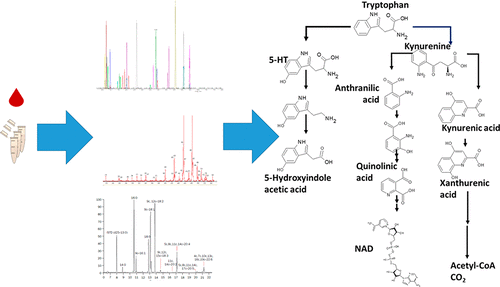当前位置:
X-MOL 学术
›
J. Proteome Res.
›
论文详情
Our official English website, www.x-mol.net, welcomes your feedback! (Note: you will need to create a separate account there.)
Metabolomics and Lipidomics Study of Mouse Models of Type 1 Diabetes Highlights Divergent Metabolism in Purine and Tryptophan Metabolism Prior to Disease Onset
Journal of Proteome Research ( IF 4.4 ) Pub Date : 2018-02-12 00:00:00 , DOI: 10.1021/acs.jproteome.7b00489 Steven A Murfitt 1 , Paola Zaccone 2 , Xinzhu Wang 1 , Animesh Acharjee 3 , Yvonne Sawyer 2 , Albert Koulman 3 , Lee D Roberts 3 , Anne Cooke 2 , Julian Leether Griffin 1, 3
Journal of Proteome Research ( IF 4.4 ) Pub Date : 2018-02-12 00:00:00 , DOI: 10.1021/acs.jproteome.7b00489 Steven A Murfitt 1 , Paola Zaccone 2 , Xinzhu Wang 1 , Animesh Acharjee 3 , Yvonne Sawyer 2 , Albert Koulman 3 , Lee D Roberts 3 , Anne Cooke 2 , Julian Leether Griffin 1, 3
Affiliation

|
With the increase in incidence of type 1 diabetes (T1DM), there is an urgent need to understand the early molecular and metabolic alterations that accompany the autoimmune disease. This is not least because in murine models early intervention can prevent the development of disease. We have applied a liquid chromatography (LC−) and gas chromatography (GC−) mass spectrometry (MS) metabolomics and lipidomics analysis of blood plasma and pancreas tissue to follow the progression of disease in three models related to autoimmune diabetes: the nonobese diabetic (NOD) mouse, susceptible to the development of autoimmune diabetes, and the NOD-E (transgenic NOD mice that express the I-E heterodimer of the major histocompatibility complex II) and NOD-severe combined immunodeficiency (SCID) mouse strains, two models protected from the development of diabetes. All three analyses highlighted the metabolic differences between the NOD-SCID mouse and the other two strains, regardless of diabetic status indicating that NOD-SCID mice are poor controls for metabolic changes in NOD mice. By comparing NOD and NOD-E mice, we show the development of T1DM in NOD mice is associated with changes in lipid, purine, and tryptophan metabolism, including an increase in kynurenic acid and a decrease in lysophospholipids, metabolites previously associated with inflammation.
中文翻译:

1 型糖尿病小鼠模型的代谢组学和脂质组学研究突出了疾病发作前嘌呤和色氨酸代谢的不同代谢
随着 1 型糖尿病 (T1DM) 发病率的增加,迫切需要了解伴随自身免疫性疾病的早期分子和代谢改变。这尤其是因为在小鼠模型中,早期干预可以预防疾病的发展。我们已应用液相色谱 (LC-) 和气相色谱 (GC-) 质谱 (MS) 代谢组学和脂质组学分析血浆和胰腺组织,以跟踪与自身免疫性糖尿病相关的三种模型中的疾病进展:非肥胖糖尿病 ( NOD) 小鼠,易患自身免疫性糖尿病,以及 NOD-E(表达主要组织相容性复合体 II 的 IE 异二聚体的转基因 NOD 小鼠)和 NOD-严重联合免疫缺陷 (SCID) 小鼠品系,这两种模型可免受糖尿病的发展。所有三个分析都强调了 NOD-SCID 小鼠和其他两个品系之间的代谢差异,无论糖尿病状态如何,表明 NOD-SCID 小鼠对 NOD 小鼠代谢变化的控制不佳。通过比较 NOD 和 NOD-E 小鼠,我们发现 NOD 小鼠 T1DM 的发展与脂质、嘌呤和色氨酸代谢的变化有关,包括犬尿酸的增加和溶血磷脂(以前与炎症相关的代谢物)的减少。
更新日期:2018-02-12
中文翻译:

1 型糖尿病小鼠模型的代谢组学和脂质组学研究突出了疾病发作前嘌呤和色氨酸代谢的不同代谢
随着 1 型糖尿病 (T1DM) 发病率的增加,迫切需要了解伴随自身免疫性疾病的早期分子和代谢改变。这尤其是因为在小鼠模型中,早期干预可以预防疾病的发展。我们已应用液相色谱 (LC-) 和气相色谱 (GC-) 质谱 (MS) 代谢组学和脂质组学分析血浆和胰腺组织,以跟踪与自身免疫性糖尿病相关的三种模型中的疾病进展:非肥胖糖尿病 ( NOD) 小鼠,易患自身免疫性糖尿病,以及 NOD-E(表达主要组织相容性复合体 II 的 IE 异二聚体的转基因 NOD 小鼠)和 NOD-严重联合免疫缺陷 (SCID) 小鼠品系,这两种模型可免受糖尿病的发展。所有三个分析都强调了 NOD-SCID 小鼠和其他两个品系之间的代谢差异,无论糖尿病状态如何,表明 NOD-SCID 小鼠对 NOD 小鼠代谢变化的控制不佳。通过比较 NOD 和 NOD-E 小鼠,我们发现 NOD 小鼠 T1DM 的发展与脂质、嘌呤和色氨酸代谢的变化有关,包括犬尿酸的增加和溶血磷脂(以前与炎症相关的代谢物)的减少。



























 京公网安备 11010802027423号
京公网安备 11010802027423号